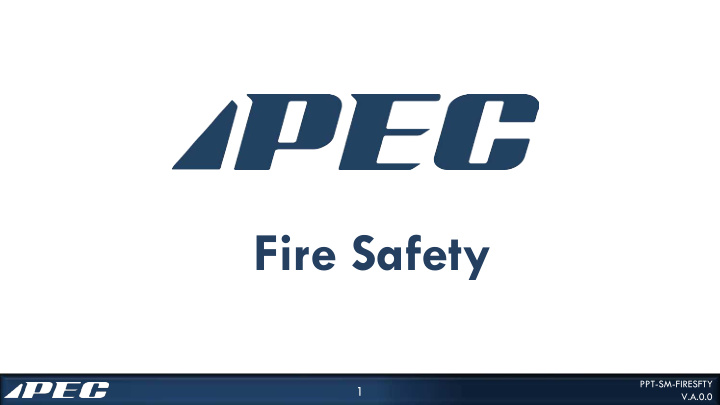



Fire Safety PPT-SM-FIRESFTY 1 V.A.0.0
Fire Theory Definition of fire • Rapid, persistent chemical change that releases heat and light • Accompanied by flame • Produces rapid oxidation PPT-SM-FIRESFTY 2 V.A.0.0
Fire Tetrahedron A fire needs four main elements to occur 1. Fuel 2. Oxygen 3. Heat 4. Chemical reaction PPT-SM-FIRESFTY 3 V.A.0.0
Fire Classification NFPA’s fire classification system is based on primary fuel metals K combustibles B A C D Hydrocarbon Energized Flammable Kitchen fires Solid and alcohol electrical based liquids equipment and gases PPT-SM-FIRESFTY 4 V.A.0.0
Workplace Fire Hazards Common workplace fire hazards • Heating, electrical and mechanical equipment • Storage and handling of combustible materials • Proximity hazards • Unauthorized smoking and poor smoking areas • Conventional cooking PPT-SM-FIRESFTY 5 V.A.0.0
Fire Prevention • Purpose – Assess potential fire hazards – Find ways to reduce risk of starting a fire – Find ways to reduce risk of injury • Fire prevention includes – Educating workers – Limiting ways a fire can start – Limiting injuries – Preparing workplace for a fire disaster PPT-SM-FIRESFTY 6 V.A.0.0
Fire Prevention Plan • Companies must develop a fire prevention plan • The plan must cover – Potential fire hazards – Procedures for fire prevention – Fire evacuation plans • Plan must be in writing and available to workers PPT-SM-FIRESFTY 7 V.A.0.0
Sources of Ignition • Inspect jobsite for sources of ignition • Identify and remove unnecessary materials • Remove sources of ignition PPT-SM-FIRESFTY 8 V.A.0.0
Sources of Ignition Potential sources of ignition Tool selection • Electrical equipment • Static electricity • Flash fires • Hot work • Kitchen fires • Other fire prevention considerations • PPT-SM-FIRESFTY 9 V.A.0.0
Prevention Good fire prevention • Keep work areas clean and clutter free • Know hazards of chemicals you work with • Respect smoking restrictions • Dispose of combustible materials • Change oil soaked or contaminated clothing • Clean up chemical spills and oil immediately PPT-SM-FIRESFTY 10 V.A.0.0
Protection Good fire protection practices • Maintain and inspect all equipment routinely • Keep fire lanes open and unobstructed • Never block access to firefighting equipment • Never move equipment or alter it in any way PPT-SM-FIRESFTY 11 V.A.0.0
Protection • Essential part of workplace safety • Forms of protection include – Detection systems – Portable extinguishers – Fixed extinguisher systems – Alarms – Trained fire brigades • Properly trained workers take part in the fire prevention system PPT-SM-FIRESFTY 12 V.A.0.0
Fire Detection • Alert workers to the presence of fire • Three forms of fire detection – Heat – Smoke – Flame • Alarms must work at all times • Maintenance and repairs – Done by qualified and designated workers PPT-SM-FIRESFTY 13 V.A.0.0
Alarm Systems • Warns workers of fire • Must have distinct sound • Qualified worker must service, maintain and test PPT-SM-FIRESFTY 14 V.A.0.0
Fire Extinguishing • Fire extinguishers eliminate elements of fire tetrahedron • If tetrahedron is broken, fire will go out • Additional cooling and water may be necessary PPT-SM-FIRESFTY 15 V.A.0.0
Methods Extinguishing methods include • Cooling and quenching • Smothering and blanketing • Oxygen dilution • Fuel removal • Chemical flame inhibition PPT-SM-FIRESFTY 16 V.A.0.0
Methods • Cooling and quenching – Reduces temperature of fuel below ignition temperature • Smothering and blanketing – Separates fuel from oxygen PPT-SM-FIRESFTY 17 V.A.0.0
Methods • Oxygen dilution – Reduces amount of available oxygen • Fuel removal – Removes fuel source PPT-SM-FIRESFTY 18 V.A.0.0
Methods Chemical flame inhibition • Interrupts combustion reaction • Stops flaming • Effective on gas and liquid fuels PPT-SM-FIRESFTY 19 V.A.0.0
Extinguisher Use To properly extinguish a fire use the PASS method • P ull the pin • A im at the base of the fire • S queeze lever • S weep back and forth PPT-SM-FIRESFTY 20 V.A.0.0
Extinguisher Use Training • Must be delivered by a qualified person • Should be conducted at – Initial employment – At least annually thereafter • Must cover – Selecting correct type of extinguisher – Discharging extinguisher in emergency situation PPT-SM-FIRESFTY 21 V.A.0.0
Training Train workers on • What to do during an emergency • Specific fire hazards • Escape procedures • Equipment use PPT-SM-FIRESFTY 22 V.A.0.0
Training If you catch on fire Stop, drop • Do not run and roll. • Drop where you are • Cover face with hands • Roll around to smother flames PPT-SM-FIRESFTY 23 V.A.0.0
Worker Responsibility • Read warnings on product labels and MSDS • Ask supervisor if any questions arise • Turn off all electrical appliances • Obey no smoking signs • When evacuating, do not use the elevator • Keep low on hands and knees • Touch door handles gently with back of hand • If outdoors, keep wind behind you PPT-SM-FIRESFTY 24 V.A.0.0
PPT-SM-FIRESFTY 25 V.A.0.0
Recommend
More recommend